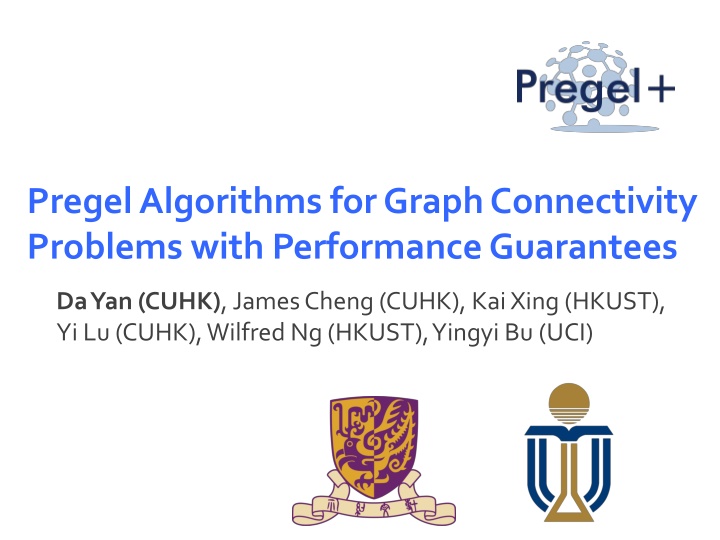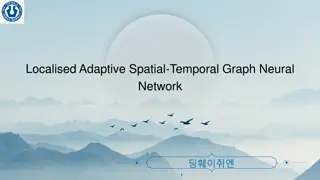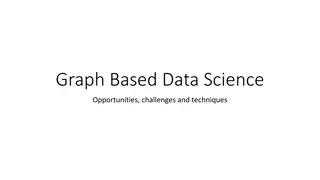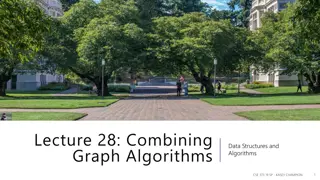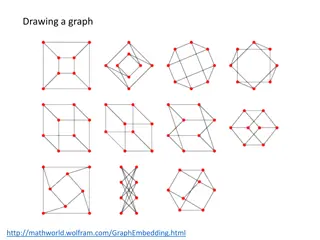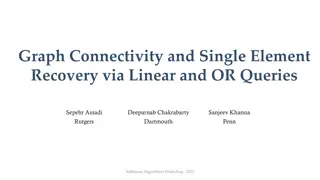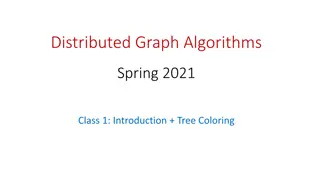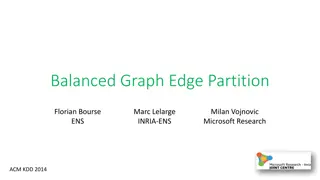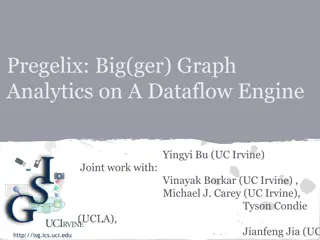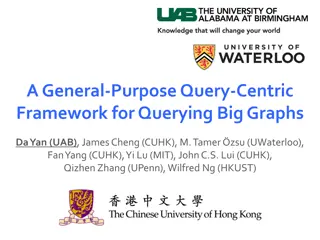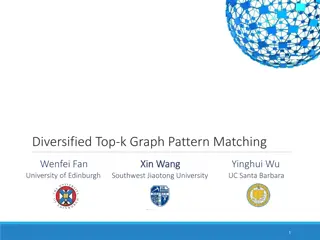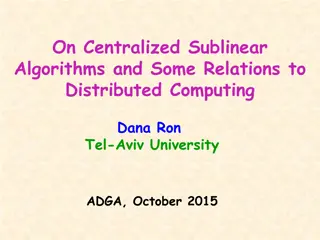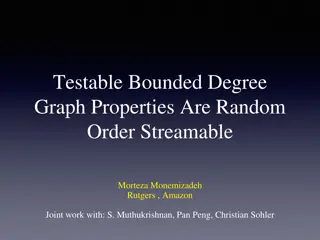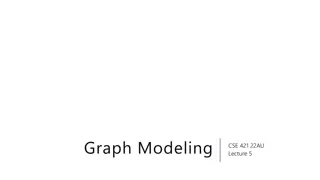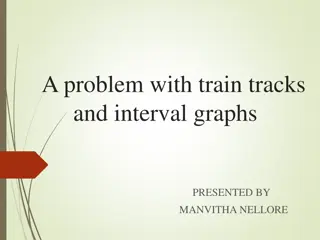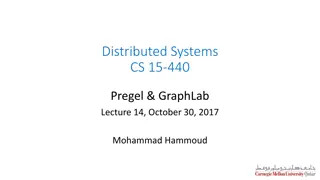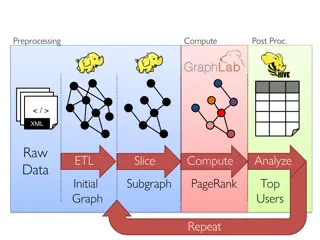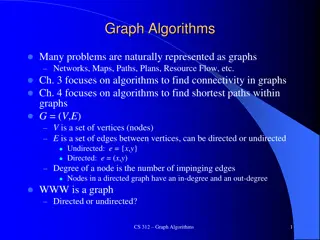Pregel Algorithms for Graph Connectivity Problems
This comprehensive work explores Pregel algorithms for graph connectivity problems with performance guarantees. Covering topics such as large-scale graph analytics, distributed graph processing systems, iterative computing, and vertex state management, this study delves into practical applications and theoretical underpinnings. With a focus on connectivity and partitioning in graph processing, this research offers insights into tackling complex network structures effectively.
Download Presentation

Please find below an Image/Link to download the presentation.
The content on the website is provided AS IS for your information and personal use only. It may not be sold, licensed, or shared on other websites without obtaining consent from the author.If you encounter any issues during the download, it is possible that the publisher has removed the file from their server.
You are allowed to download the files provided on this website for personal or commercial use, subject to the condition that they are used lawfully. All files are the property of their respective owners.
The content on the website is provided AS IS for your information and personal use only. It may not be sold, licensed, or shared on other websites without obtaining consent from the author.
E N D
Presentation Transcript
Pregel Algorithms for Graph Connectivity Problems with Performance Guarantees Da Yan (CUHK), James Cheng (CUHK), Kai Xing (HKUST), Yi Lu (CUHK), Wilfred Ng (HKUST), Yingyi Bu (UCI)
Outline Pregel Review Cost Model: PPA Graph Connectivity PPAs Conclusion 2
Large-Scale Graph Analytics Online social networks Facebook, Twitter Web graphs The Semantic Web Freebase Spatial networks Road network, terrain mesh 3
Distributed Graph Processing Systems Think like a vertex / vertex-centric programming Synchronous Pregel, Giraph, GPS, Asynchronous GraphLab (PowerGraph), We focus on the BSP model of Pregel 4
Pregel Review Graph partitioning Distribute vertices along with their adjacency lists to machines 1 2 4 5 6 0 3 7 8 1 3 0 1 2 7 0 2 3 2 5 7 1 3 4 7 4 6 0 3 1 4 2 5 5 8 2 3 4 8 6 7 6 7 8 M0 M1 M2 5
Pregel Review Iterative computing Superstep, barrier Message passing Programming interfaces u.compute(msgs) u.send_msg(v) get_superstep_number() u.vote_to_halt() Called inside u.compute(msgs) 6
Pregel Review Vertex state Active / inactive Reactivated by messages Stop condition All vertices are halted, and No pending messages for the next superstep 7
Example: Connected Components Hash-Min: O( ) supersteps Each vertex v broadcasts the smallest vertex (ID) it sees so far, denoted by min(v) Initialize min(v) as the smallest vertex among v and its neighbors In a superstep, v obtains the smallest vertex from the incoming messages, denoted by u If u < min(v), v sets min(v) = u and sends min(v) to all its neighbors Finally, v votes to halt 8
Example: Connected Components Hash-Min 3 1 1 0 7 5 0 6 8 5 0 0 0 6 2 0 4 2 Superstep 1 9
Example: Connected Components Hash-Min 3 0 1 There are still pending messages 0 7 5 0 6 8 0 0 0 0 0 2 0 4 0 Superstep 2 10
Example: Connected Components Hash-Min 3 0 1 0 7 5 0 6 8 0 0 0 0 0 2 0 No pending message, terminate 4 0 Superstep 3 11
Outline Pregel Review Cost Model: PPA Graph Connectivity PPAs Conclusion 12
Cost Model Requirement on the whole graph How about load balancing? Practical Pregel Algorithm (PPA) Linear cost per superstep O(|V| + |E|) message number O(|V| + |E|) computation time O(|V| + |E|) RAM space Logarithm number of supersteps O(log |V|) supersteps O(log|V|) = O(log|E|) 13
Cost Model Balanced Practical Pregel Algorithm (BPPA) din(v): in-degree of v dout(v): out-degree of v Linear cost per superstep O(din(v) + dout(v)) message number O(din(v) + dout(v)) computation time O(din(v) + dout(v)) RAM space Logarithm number of supersteps e.g., one msg along each out-edge e.g., incoming msg & out-edges 14
Outline Pregel Review Cost Model: PPA Graph Connectivity PPAs Conclusion 15
Roadmap of Our Algorithms Using PPAs as building blocks for guaranteed efficient distributed computing: Connected components (CCs) Bi-connected components (BCCs) List ranking, CCs, Spanning tree, Euler tour, Strongly connected components (SCCs) List Ranking CC Spanning tree BCC Euler Tour We use rectangle to represent a PPA Dangling Vertex Removal Label Propagation SCC 16
Outline Pregel Review Cost Model: PPA Graph Connectivity PPAs Connected Component (CC) List Ranking Conclusion 17
Algorithms for Computing CCs S-V: O(log |V|) supersteps Adapted from Shiloach-Vishkin s PRAM algorithm Pointer jumping, or doubling Each vertex u maintains a pointer D[u] Vertices are organized by a pseudo-forest, D[u] is the parent link 18
Algorithms for Computing CCs S-V: O(log |V|) supersteps Adapted from Shiloach-Vishkin s PRAM algorithm Pointer jumping, or doubling Proceeds in rounds; each round has 3 steps 19
Algorithms for Computing CCs S-V: O(log |V|) supersteps Step 1: tree hooking x w v u D[v] < D[u] 20
Algorithms for Computing CCs S-V: O(log |V|) supersteps Step 2: star hooking x Require D[v] < D[u] in Pregel v w u No constraint in PRAM S-V 21
Algorithms for Computing CCs S-V: O(log |V|) supersteps Step 2: star hooking 4 1 1 2 3 2 5 6 3 4 5 6 Graph Pseudo-Forest (4, 5): D[1] = 2 (5, 6): D[2] = 3 (6, 4): D[3] = 1 CYCLE ! 22
Algorithms for Computing CCs S-V: O(log |V|) supersteps Step 3: Shortcutting Pointing v to the parent of v s parent y x y x w w u u 23
Algorithms for Computing CCs S-V: O(log |V|) supersteps Stop condition: D[u] converges for every vertex u Every vertex belongs to a star Every star refers to a CC 24
Outline Pregel Review Cost Model: PPA Graph Connectivity PPAs Connected Component (CC) List Ranking Conclusion 25
Algorithms for List Ranking List Ranking A procedure in computing bi-connected components Linked list where each element v has Value val(v) Predecessor pred(v) Element at the head has pred(v) = NULL v1 v2 v3 v4 v5 NULL 1 1 1 1 1 Toy Example: val(v) = 1 for all v 26
Algorithms for List Ranking List Ranking Compute sum(v) for each element v summing val(v) and values of all predecessors Why TeraSort cannot work? v1 v2 v3 v4 v5 NULL 1 2 3 4 5 27
Algorithms for List Ranking List Ranking Pointer jumping / doubling sum(v) sum(v) + sum(pred(v)) pred(v) pred(pred(v)) As long as pred(v) NULL v1 v2 v3 v4 v5 NULL 1 1 1 1 1 28
Algorithms for List Ranking List Ranking Pointer jumping / doubling sum(v) sum(v) + sum(pred(v)) pred(v) pred(pred(v)) v1 v2 v3 v4 v5 NULL NULL 1 1 1 1 1 1 2 2 2 2 29
Algorithms for List Ranking List Ranking Pointer jumping / doubling sum(v) sum(v) + sum(pred(v)) pred(v) pred(pred(v)) v1 1 v2 1 v3 1 v4 1 v5 1 NULL NULL 1 2 2 2 2 NULL 1 2 3 4 4 30
Algorithms for List Ranking List Ranking Pointer jumping / doubling sum(v) sum(v) + sum(pred(v)) pred(v) pred(pred(v)) O(log n) supersteps v1 1 v2 1 v3 1 v4 1 v5 1 NULL NULL 1 2 2 2 2 NULL 1 2 3 4 4 NULL 1 2 3 4 5 31
Outline Pregel Review Cost Model: PPA Graph Connectivity PPAs Conclusion 32
Conclusion PPA (Cost Model) Linear cost per superstep Logarithm number of supersteps CC, BCC, SCC CC, BCC: pointer jumping SCC: label propagation & recursive partitioning All algorithms implemented in Pregel+ 33
More on Pregel+ Cost Model & Algorithm Design Pregel Algorithms for Graph Connectivity Problems with Performance Guarantees [PVLDB'14] Message Reduction Effective Techniques for Message Reduction and Load Balancing in Distributed Graph Computation [WWW'15] System Performance Comparison Large-Scale Distributed Graph Computing Systems: An Experimental Evaluation [PVLDB'15] 34
